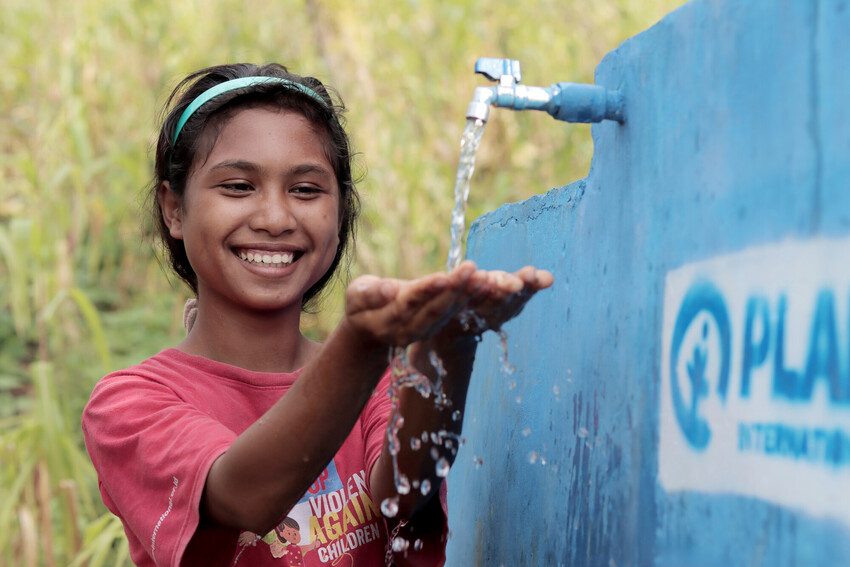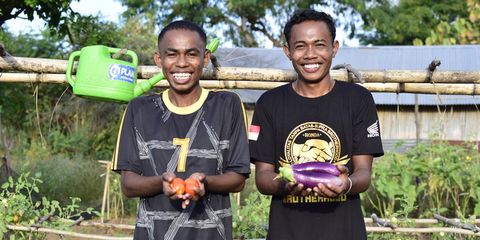Clean water for Eci’s village
Clean water now flows through Eci’s village, ending long, dangerous treks to the river and ensuring children like Eci can attend school on time, every day.

Eci, 14, collects water from one of the new water points in her village. © Plan International
The people of Eci’s village in Nagekeo, a regency in Indonesia’s East Nusa Tenggara province, have long relied on clean water from Pela, a hidden spring by the river that winds around their small village. Every morning, just after dawn, the children would rush to the river to wash before school.
“Once the children had gone to school, it was our turn, the mothers, to go to the river to wash clothes, bathe and collect water. The men go to the fields and feed the livestock,” says Eci’s mother, 49-year-old Mama Reta.
The footpath to the river is narrow, only wide enough for 1 person. It curves along the hillside with steep inclines. In some places, the ground is slippery and rocky, so every step must be taken carefully. A small misstep could result in a dangerous fall.
“It’s downhill on the way there, but uphill on the way back with water and washed clothes. During the rainy season, the river floods, so we collect rainwater for use. It’s been this way since I was a child,” explains Mama Reta.
For children like 14-year-old Eci, fetching water is an unavoidable daily task. “We hike back uphill. If we get tired, we stop and rest before walking again. Once we get home, we get ready for school. Sometimes we’re late. If we are, we are punished by having to kneel,” says Eci.
Water was also scarce at school. Each student brought their own water from home to fill the tank used for washing hands, rinsing faces and flushing toilets. If the water ran out, the teachers and students had to work together to fetch more from the river.
Overcoming technical challenges
Bringing clean water to the village proved to be a technical challenge. “The hardest part was realising that we would need a huge amount of electricity to pump water up to the village,” explains project manager Kosmin. “The existing meter couldn’t support the pump because we used an anti-gravity method. After conducting engineering trials, we discovered that 10,600 watts were required to lift the water to the reservoir.”
After the electricity meter was upgraded, the rainy season floods hit the river just as the pump installation was about to begin. Gravel and sand were swept into the pump, causing it to burn out. These technical problems sparked social unrest.
Villagers who believed in mystical causes began to doubt the project. Participation dropped. Some became apathetic and stopped taking part in community activities. At one point, project staff were driven away by some residents. In response, steps were taken to reignite the community’s spirit of cooperation.
A resolution was finally reached when a replacement pump arrived and water from the Pela river reached the village. The whole community gathered to watch the 10,600-watt electricity meter being switched on and the water flowing through the village’s 14 public taps via a vast network of pipes.
A new way of life
Public water points are now spread throughout the village, providing clean water to all residents. The distance from each house to the nearest tap is now only 5 to 20 metres. The community has also formed a Villager Water Management Body, which has received training in water system maintenance and infrastructure development.
Mama Reta says that her prayers and dreams have been answered. “Now the water is close to our homes. The children don’t have to walk all the way to the river to wash before school. We never thought this would be possible, but now it is.”
Standing beside her mother, Eci smiles. “We don’t fetch water from the river anymore. Now, in the mornings, I help Mama cook, then I wash and get ready for school. I’m never late, and the teachers don’t ask us to bring water to school anymore.”


